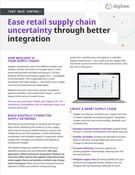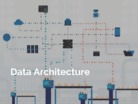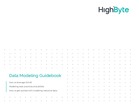Must-have API management components
By: Software AG View more from Software AG >>
Download this next:
Ease Retail Supply Chain Uncertainty with Better Integration
By: Digibee
Type: White Paper
How can you proactively mitigate your supply chain risk — diminishing vulnerabilities that can negatively impact your revenue and brand?
The right integration platform can help you transform your supply chain into a resilient, digitally connected ecosystem. Integration enables real-time, end-to-end visibility, flexibility, and scalability that:
- Manages inventory levels in real time
- Handles variability
- Increases efficiency
- And more
Read on to learn how Digibee’s integration solution may be able to help you solve your complex integration challenges quickly, at scale, and with confidence.
These are also closely related to: "Must-have API management components"
-
How to choose the perfect integration architecture for your needs
By: HighByte
Type: Blog
Integration architectures fall in two camps: direct application programming interface (API) connections (application-to-application) or integration hubs (DataOps solutions).
Direct API connections work well if you only have two applications that need to be integrated. DataOps is a new approach to data integration and security that aims to improve data quality and reduce time spent preparing data for use throughout the enterprise.
Read this blog to explore both options and learn how to select the perfect integration architecture for your needs.
-
Your quick start to modeling industrial data
By: HighByte
Type: eBook
Digital transformation is providing industrial organizations with an unprecedented amount of visibility and predictive insights. However, connecting machines to data storage platforms or enterprise systems isn’t always seamless, often requiring a standardized approach to defining and categorizing data.
HighByte is here to provide a comprehensive overview of data modeling and why it’s essential for every industrial environment – no matter where the organization stands along its digital journey.
Check out HighByte’s e-book to gain a better understanding of how data modeling works, what it looks like, how it works with existing standards, and to gather tips on how to establish a data modeling strategy.
Find more content like what you just read:
-
DataOps in 2022: Key findings & market analysis
By: HighByte
Type: Analyst Report
For many reasons, the complexity of today’s data ecosystem hinders the democratization of data and analytics. This e-book by ESG provides insights on how to improve the quality, delivery and management of data/analytics at scale using DataOps. Explore this e-book to learn key findings and use the report to compare your performance to your peers.
-
How to apply lean manufacturing to data management
By: HighByte
Type: eBook
The volume, velocity and variety of raw industrial data are ever increasing, making it difficult to work with. Fortunately, manufacturers already have the framework they need to streamline data production and preparation. Read on to learn how you can enable your organization with lean data.
-
Contextualized Data Where It Matters
By: HighByte
Type: Blog
There are several obstacles that IT teams must overcome in order to make IoT data usable for the organization. Access this blog post to learn why industrial DataOps is key for organizations that are looking to maximize the ROI of their digital investments and deliver contextualized data where it matters.
-
InterSystems TotalView: Game-changers for asset management
By: InterSystems
Type: Case Study
Harris Associates boosts performance using InterSystems data platform. Its smart data fabric architecture leverages internal and external data for reporting, trade analysis, and more. Discover how they enhanced portfolio returns, minimized risk, and heightened efficiency with InterSystems TotalView for Asset Management.
-
Deliver Data Products with Data Intelligence
By: Alation
Type: White Paper
More and more, data is being packaged into consumable, ready-to-use elements. It’s data as a product. Read on to learn how you can enable data consumers to look beyond warehouses and custom data processing and use reliable and consistent data to deliver business outcomes, including 8 key steps to get started with data products using a data catalog.
-
Schneider Electric Enhances Data Integration with Qlik
By: Qlik
Type: Case Study
Schneider Electric enhanced data integration and insight speed with Qlik Data Integration. Utilizing Qlik's change data capture tech, Schneider hit higher data accuracy and cut extraction times from days to hours. Discover how Qlik Data Integration sped up Schneider's DataOps in the full story.
-
Data harmonization: Unify disparate data for better insights
By: DataVid
Type: Blog
Learn how data harmonization can transform fragmented data into a unified symphony of insights. This blog post covers the steps and best practices for standardizing and integrating data across your organization. Read the full article now to discover the benefits of data harmonization.
-
Enhancing R&D document search for a global company
By: DataVid
Type: Case Study
By collaborating with Datavid, a global agrochemical firm launched a cognitive search tool that streamlined data across 160M+ legacy documents, enabling swift, accurate searches and turning weeks of research into minutes, thereby saving time and resources. Read the full case study now to discover how you can enhance R&D data handling.
-
Boost your IT strategy with data-driven initiatives
By: DataVid
Type: Blog
This article explores how data-driven initiatives can enhance IT strategies and data utilization. It addresses data integration and governance evolution, highlighting how they can help tackle silos and management complexities. Read on now to learn how you can empower IT initiatives with modern data technology.
-
Overcome data silos with knowledge graphs and AI
By: DataVid
Type: Blog
The explosion of data has resulted in knowledge silos for many organizations, blocking vital information flow. This article discusses the potential of solutions like data hubs, knowledge graphs, and AI to break down these barriers. Read the full blog post now to discover how you can empower your business with integrated intelligence.
-
9 ways to scale AI with data integration and "Super iPaaS"
By: Software AG
Type: White Paper
As enterprises scale AI, data integration is critical to overcoming challenges like data silos, quality, and security. This white paper explores how modern data integration solutions can provide the foundation for successful, scalable AI initiatives. Learn more by reading the full white paper.
-
Insights on the business impact of data engineering & team satisfaction
By: Software AG
Type: Research Content
StreamSets' report, based on surveys from 523 data engineers and 778 business data consumers, reveals the value of data engineering. It highlights the need for engineers to grasp business impact, better collaboration, and factors for job satisfaction. Discover how to maximize your data team's potential in the report.


